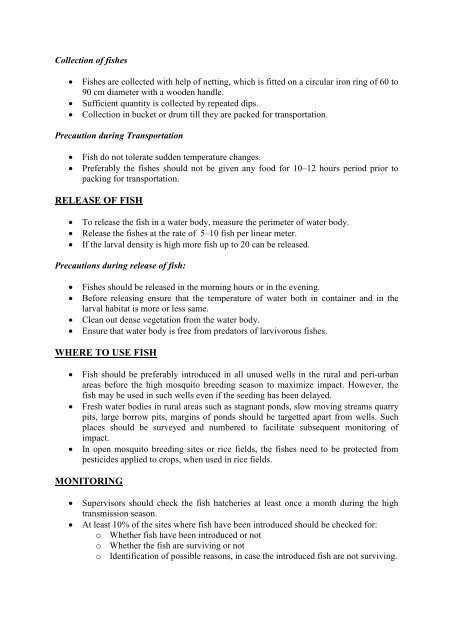guidelines on the use of larvivorous fish for vector control - NVBDCP
guidelines on the use of larvivorous fish for vector control - NVBDCP
guidelines on the use of larvivorous fish for vector control - NVBDCP
Create successful ePaper yourself
Turn your PDF publications into a flip-book with our unique Google optimized e-Paper software.
Collecti<strong>on</strong> <strong>of</strong> <strong>fish</strong>esFishes are collected with help <strong>of</strong> netting, which is fitted <strong>on</strong> a circular ir<strong>on</strong> ring <strong>of</strong> 60 to90 cm diameter with a wooden handle.Sufficient quantity is collected by repeated dips.Collecti<strong>on</strong> in bucket or drum till <strong>the</strong>y are packed <strong>for</strong> transportati<strong>on</strong>.Precauti<strong>on</strong> during Transportati<strong>on</strong>Fish do not tolerate sudden temperature changes.Preferably <strong>the</strong> <strong>fish</strong>es should not be given any food <strong>for</strong> 10–12 hours period prior topacking <strong>for</strong> transportati<strong>on</strong>.RELEASE OF FISHTo release <strong>the</strong> <strong>fish</strong> in a water body, measure <strong>the</strong> perimeter <strong>of</strong> water body.Release <strong>the</strong> <strong>fish</strong>es at <strong>the</strong> rate <strong>of</strong> 5–10 <strong>fish</strong> per linear meter.If <strong>the</strong> larval density is high more <strong>fish</strong> up to 20 can be released.Precauti<strong>on</strong>s during release <strong>of</strong> <strong>fish</strong>:Fishes should be released in <strong>the</strong> morning hours or in <strong>the</strong> evening.Be<strong>for</strong>e releasing ensure that <strong>the</strong> temperature <strong>of</strong> water both in c<strong>on</strong>tainer and in <strong>the</strong>larval habitat is more or less same.Clean out dense vegetati<strong>on</strong> from <strong>the</strong> water body.Ensure that water body is free from predators <strong>of</strong> <strong>larvivorous</strong> <strong>fish</strong>es.WHERE TO USE FISHFish should be preferably introduced in all un<strong>use</strong>d wells in <strong>the</strong> rural and peri-urbanareas be<strong>for</strong>e <strong>the</strong> high mosquito breeding seas<strong>on</strong> to maximize impact. However, <strong>the</strong><strong>fish</strong> may be <strong>use</strong>d in such wells even if <strong>the</strong> seeding has been delayed.Fresh water bodies in rural areas such as stagnant p<strong>on</strong>ds, slow moving streams quarrypits, large borrow pits, margins <strong>of</strong> p<strong>on</strong>ds should be targetted apart from wells. Suchplaces should be surveyed and numbered to facilitate subsequent m<strong>on</strong>itoring <strong>of</strong>impact.In open mosquito breeding sites or rice fields, <strong>the</strong> <strong>fish</strong>es need to be protected frompesticides applied to crops, when <strong>use</strong>d in rice fields.MONITORINGSupervisors should check <strong>the</strong> <strong>fish</strong> hatcheries at least <strong>on</strong>ce a m<strong>on</strong>th during <strong>the</strong> hightransmissi<strong>on</strong> seas<strong>on</strong>.At least 10% <strong>of</strong> <strong>the</strong> sites where <strong>fish</strong> have been introduced should be checked <strong>for</strong>:o Whe<strong>the</strong>r <strong>fish</strong> have been introduced or noto Whe<strong>the</strong>r <strong>the</strong> <strong>fish</strong> are surviving or noto Identificati<strong>on</strong> <strong>of</strong> possible reas<strong>on</strong>s, in case <strong>the</strong> introduced <strong>fish</strong> are not surviving.
















